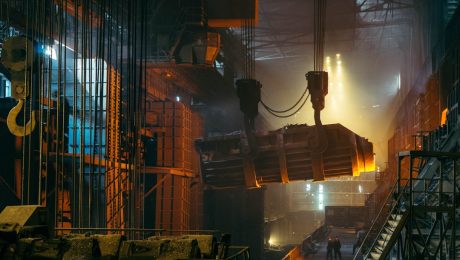The world of steel is undergoing a significant transformation thanks to the advent of nanotechnology. Nanomaterials and nano-engineered processes are revolutionizing steel surface treatments, offering unprecedented improvements in properties like corrosion resistance, wear resistance, hardness, and overall durability. This blog post delves into the fascinating world of nanotech in steel surface treatments, exploring various techniques and their impact on diverse industries.
1. Enhanced Corrosion Resistance through Nanocoatings
Corrosion is a major concern for steel structures, leading to significant economic losses and safety hazards. Traditional methods of corrosion protection often involve bulky coatings that can be less durable and environmentally unfriendly. Nanotechnology offers a powerful alternative. Nanocoatings, typically composed of nanoparticles of materials like zinc oxide, titanium dioxide, or cerium oxide, provide exceptional corrosion protection. These nanoparticles create a dense, uniform layer that effectively prevents the penetration of corrosive agents like oxygen and water. The small size of the nanoparticles allows for superior adhesion and coverage, leading to a more robust and long-lasting protective barrier. Furthermore, some nanocoatings exhibit self-healing properties, meaning they can repair minor scratches and imperfections, maintaining their protective function over extended periods. This is a significant improvement over traditional coatings which often require frequent maintenance and replacement.
2. Superior Wear Resistance with Nano-Structured Surfaces
In applications where steel components experience high levels of friction and wear, such as in automotive parts, machinery, and tooling, the durability of the surface is paramount. Nanotechnology offers innovative solutions to enhance wear resistance. Techniques like nano-indentation and laser surface modification can create nano-structured surfaces with significantly improved hardness and wear resistance. These techniques modify the surface topography at the nanoscale, creating a harder, more resilient surface layer. For example, creating a nano-crystalline surface layer increases the density and reduces the number of grain boundaries, thus improving the material’s resistance to wear and tear. The resulting enhanced performance translates to longer component lifespan and reduced maintenance costs.
3. Enhancing Steel Strength and Hardness via Nanoparticle Dispersion
The mechanical properties of steel, such as strength and hardness, are crucial for its performance in various applications. Nanotechnology offers the potential to enhance these properties by incorporating nanoparticles into the steel matrix. The dispersion of nanoparticles, such as carbon nanotubes or ceramic nanoparticles, within the steel microstructure can refine the grain size and improve the overall strength and hardness of the material. This process, often achieved through powder metallurgy or other advanced techniques, results in a stronger and more durable steel with improved resistance to deformation and fracture. The resulting material can withstand higher stresses and strains, making it suitable for high-performance applications.
4. The Role of Nano-Structured Coatings in Reducing Friction
Friction is a significant factor leading to wear and energy loss in many mechanical systems. Nano-structured coatings can significantly reduce friction by creating ultra-smooth surfaces with low surface energy. These coatings, often composed of materials like diamond-like carbon (DLC) or molybdenum disulfide (MoS2) nanoparticles, can reduce friction coefficients by up to 50% compared to untreated steel. This reduction in friction translates to improved efficiency, reduced energy consumption, and extended component lifespan. The application of these coatings is particularly beneficial in high-speed and high-precision machinery, where minimizing friction is crucial for optimal performance and energy savings.
5. Future Trends and Challenges in Nanotech Steel Surface Treatments
The field of nanotechnology in steel surface treatments is constantly evolving. Future trends include the development of more sophisticated nanocoatings with enhanced functionalities, such as self-cleaning, anti-fouling, and antibacterial properties. Furthermore, research is focused on developing more environmentally friendly and sustainable nano-based solutions for steel surface treatment. Challenges remain in scaling up the production of nano-enhanced steel components to meet industrial demands and ensuring the long-term stability and durability of the nano-engineered surfaces. Cost-effectiveness is another crucial factor that needs to be addressed to enable wider adoption of these technologies across various industries. Despite these challenges, the future of nanotech in steel surface treatments is bright, promising significant advancements in material performance and sustainability.
The application of nanotechnology in steel surface treatments represents a significant leap forward in material science, offering a wide range of benefits across numerous industries. From enhancing corrosion and wear resistance to improving strength and reducing friction, nanotechnologies are poised to redefine the capabilities and lifespan of steel components, leading to more efficient, durable, and sustainable solutions for the future.
SEO Tags:
#Nanotechnology #SteelSurfaceTreatment #Nanocoatings #CorrosionResistance #WearResistance
Expanding your business to 40+ countries is an ambitious but achievable goal. It requires a well-defined strategy, meticulous planning, and a deep understanding of international trade. This guide provides a roadmap to navigate the complexities of global expansion, helping you successfully reach new markets and boost your revenue.
1. Thorough Market Research: Identifying Your Target Markets
Before diving into logistics and regulations, thorough market research is paramount. Don’t treat all 40+ countries as a monolithic entity. Each possesses unique cultural nuances, consumer preferences, economic conditions, and regulatory frameworks. Your research should identify:
- Market Size and Potential: Analyze the demand for your product or service in each target country. Consider factors like population size, disposable income, and competition.
- Consumer Behavior and Preferences: Understand cultural sensitivities, purchasing habits, and preferred communication channels. Adapt your marketing materials accordingly.
- Competitive Landscape: Identify key competitors, analyze their strengths and weaknesses, and develop a competitive advantage.
- Import Regulations and Tariffs: Research import duties, taxes, and any specific regulations that may affect your products.
- Distribution Channels: Determine the most effective ways to reach your target customers, whether through direct sales, distributors, or online marketplaces.
Utilize resources like market research reports, industry publications, government websites, and trade associations to gather comprehensive data.
2. Navigating Export Regulations and Compliance
Exporting to multiple countries means navigating a complex web of regulations. Non-compliance can lead to significant delays, fines, and even legal repercussions. Key aspects to consider include:
- Export Licenses and Permits: Determine if you need any specific licenses or permits to export your products to each country. These requirements vary significantly depending on the product and destination.
- Customs Procedures and Documentation: Familiarize yourself with the customs procedures in each target country. Accurate and complete documentation is essential for smooth customs clearance.
- Product Labeling and Packaging Requirements: Ensure your products meet all labeling and packaging requirements, including language requirements and safety standards.
- Intellectual Property Protection: Protect your intellectual property rights in each target market by registering patents, trademarks, and copyrights.
- Sanctions and Embargoes: Stay informed about any sanctions or embargoes that may restrict trade with certain countries.
Engaging a customs broker or international trade consultant can significantly simplify this process.
3. Optimizing Your Logistics and Supply Chain
Efficient logistics are crucial for cost-effective and timely delivery. Consider these aspects:
- Choosing the Right Shipping Method: Select the most appropriate shipping method based on factors like cost, speed, and product fragility. Options include sea freight, air freight, and courier services.
- International Freight Forwarders: Partner with reputable freight forwarders who have experience handling international shipments to your target markets.
- Inventory Management: Implement an efficient inventory management system to ensure you have sufficient stock to meet demand in each market without excessive storage costs.
- Warehousing and Distribution: Consider establishing warehouses or distribution centers in strategic locations to reduce shipping times and costs.
- Supply Chain Risk Management: Develop strategies to mitigate potential risks, such as delays, disruptions, and natural disasters.
A well-optimized supply chain can significantly reduce costs and improve efficiency.
4. Crafting a Multilingual Marketing Strategy
Effective marketing is essential for success in international markets. Consider:
- Language Localization: Translate your marketing materials into the local languages of your target markets. Simple translation isn’t enough; cultural adaptation is key.
- Cultural Adaptation: Tailor your marketing messages to resonate with the cultural values and preferences of each target market.
- Digital Marketing Strategies: Utilize various digital marketing channels, such as social media, search engine optimization (SEO), and pay-per-click (PPC) advertising, to reach your target audiences.
- Local Partnerships: Collaborate with local distributors, influencers, or marketing agencies to enhance your reach and credibility.
- Market Entry Strategies: Choose the best market entry strategy for each country, such as direct export, indirect export, joint ventures, or foreign direct investment.
A localized and culturally sensitive marketing strategy is critical for building brand awareness and generating sales.
5. Managing Financial and Legal Aspects
Expanding to 40+ countries requires careful financial and legal planning. Key considerations include:
- Currency Exchange Rates: Manage currency fluctuations to minimize financial risks.
- International Payment Methods: Utilize secure and efficient international payment methods, such as letters of credit or electronic funds transfers.
- Tax Implications: Understand the tax implications of operating in each target market and ensure compliance with all relevant tax laws.
- Legal Compliance: Ensure compliance with all relevant local laws and regulations in each target market.
- Insurance: Obtain appropriate insurance coverage to protect your business from potential risks, such as shipping damage, product liability, and political instability.
Seeking professional advice from accountants, lawyers, and financial experts is highly recommended.
Successfully exporting to 40+ countries requires a long-term commitment, careful planning, and adaptability. By following these strategies and continuously monitoring market conditions, you can increase your chances of success in the global marketplace.
SEO Tags:
export strategy, international trade, global expansion, market research, export regulations
In today’s competitive market, product quality and safety are paramount. Test reports and certifications play a crucial role in demonstrating compliance with industry standards, regulations, and customer expectations. This comprehensive guide will delve into the world of test reports and certifications, explaining their significance, types, and the processes involved in obtaining them.
Understanding the Importance of Test Reports
Test reports are formal documents that record the results of various tests performed on a product, process, or system. These reports provide objective evidence of a product’s performance, functionality, and adherence to specified requirements. A well-structured test report should include:
- Test objective: Clearly defining the purpose of the testing.
- Test methodology: Detailing the procedures and standards followed.
- Test environment: Describing the conditions under which the tests were conducted.
- Test results: Presenting the data obtained, including both pass and fail results.
- Analysis and conclusions: Interpreting the results and drawing relevant conclusions.
- Recommendations: Suggesting improvements or further actions based on the findings.
The importance of comprehensive test reports cannot be overstated. They serve as crucial evidence in:
- Demonstrating product quality: Providing objective proof of a product’s fitness for purpose.
- Meeting regulatory requirements: Ensuring compliance with relevant laws and standards.
- Building customer trust: Instilling confidence in the product’s safety and reliability.
- Improving product development: Identifying areas for improvement and driving continuous enhancement.
- Supporting legal claims: Providing evidence in case of disputes or product liability issues.
The Significance of Product Certifications
Product certifications go a step further than test reports. They are official endorsements issued by independent third-party organizations, verifying that a product meets specific standards and requirements. These certifications provide a recognized mark of quality and compliance, offering several benefits:
- Enhanced credibility: Demonstrating a higher level of quality and reliability.
- Increased market access: Opening doors to new markets and customers who require certified products.
- Reduced risk: Minimizing the risk of product recalls or legal issues.
- Competitive advantage: Differentiating a product from competitors and commanding premium prices.
- Improved customer satisfaction: Building trust and confidence among customers.
Examples of common certifications include ISO 9001 (quality management), ISO 14001 (environmental management), CE marking (European conformity), and UL certification (safety testing).
Types of Testing and Corresponding Reports
The type of testing conducted dictates the content and format of the test report. Different testing methodologies are employed depending on the product and its intended use. Some common types include:
- Functional Testing: Verifying that the product meets its specified functionality.
- Performance Testing: Evaluating the product’s speed, scalability, and stability under various loads.
- Security Testing: Assessing the product’s vulnerability to security threats.
- Usability Testing: Determining the ease of use and user experience.
- Compliance Testing: Ensuring the product meets regulatory and industry standards.
Each of these testing types will generate a specific report outlining the methodology, results, and conclusions relevant to that particular area. For example, a performance test report might include graphs showing response times under different loads, while a security test report might list identified vulnerabilities and their severity.
The Certification Process: A Step-by-Step Guide
Obtaining a product certification typically involves a multi-step process:
- Product Selection: Identifying the specific product or system to be certified.
- Standard Selection: Choosing the relevant standard or specification to be met.
- Application Submission: Submitting an application to the certification body, providing relevant documentation.
- Testing and Audits: Undergoing rigorous testing and audits by the certification body.
- Corrective Actions: Addressing any identified non-conformances or deficiencies.
- Certification Issuance: Receiving the certification upon successful completion of the process.
- Surveillance Audits: Undergoing periodic surveillance audits to maintain certification.
The specific requirements and timelines vary depending on the certification body and the chosen standard.
Analyzing Test Reports and Interpreting Certification Marks
Understanding and interpreting test reports and certification marks is crucial for making informed decisions. When analyzing a test report, focus on:
- The scope of testing: Ensuring that all relevant aspects have been covered.
- The methodology used: Evaluating the validity and reliability of the testing procedures.
- The results obtained: Identifying any significant deviations from expectations.
- The conclusions drawn: Assessing the overall implications of the findings.
Similarly, when interpreting certification marks, understand the specific standard or regulation that the certification represents. Look for the certification body’s logo and the scope of the certification. Be aware that not all certifications are created equal, so research the reputation and credibility of the issuing body.
Test reports and certifications are indispensable tools for ensuring product quality, safety, and compliance. By understanding their significance, processes, and interpretations, businesses can leverage them to build trust, enhance their market position, and ultimately achieve success.
Tags: test reports, certifications, quality assurance, product testing, compliance
Liquefied Natural Gas (LNG) pipelines represent a crucial component of the global energy infrastructure, enabling the safe and efficient transportation of this vital resource. However, the unique challenges presented by transporting cryogenic fluids necessitate stringent specifications for pipeline design, construction, and operation. This comprehensive guide delves into the key aspects of LNG pipeline specifications, providing a detailed understanding of the complexities involved.
1. Material Selection: The Foundation of Cryogenic Resilience
The choice of materials for LNG pipelines is paramount due to the extremely low temperatures (-162°C) involved. Standard steel pipelines are unsuitable due to the risk of brittle fracture at such low temperatures. Therefore, specialized materials with exceptional cryogenic properties are employed. These include:
- Austenitic Stainless Steels: These steels possess a face-centered cubic crystal structure that maintains ductility and toughness even at cryogenic temperatures. Grades like 304L, 316L, and 9% Ni steel are commonly used.
- Nickel Alloys: Alloys like Incoloy and Inconel offer superior strength and corrosion resistance at cryogenic temperatures, making them suitable for high-pressure applications.
- Aluminum Alloys: Certain aluminum alloys exhibit excellent cryogenic properties and are lighter than steel, potentially reducing construction costs in specific applications. However, their susceptibility to stress corrosion cracking needs careful consideration.
The selection of specific materials often depends on factors such as pipeline diameter, operating pressure, soil conditions, and the overall cost-benefit analysis.
2. Pressure Rating and Wall Thickness: Ensuring Safe Operation
LNG pipelines operate under significant pressure to maintain the liquefied state of the gas. The pressure rating, expressed in bars or psi, dictates the maximum allowable operating pressure. This rating is determined by several factors, including:
- Pipeline Diameter: Larger diameter pipelines generally require thicker walls to withstand the same pressure.
- Material Properties: The yield strength and ultimate tensile strength of the chosen material directly influence the allowable pressure.
- Operating Temperature: The low temperature of LNG affects the material’s properties, requiring adjustments to the pressure rating calculations.
- Safety Factor: A substantial safety factor is incorporated to account for uncertainties and potential variations in operating conditions.
Accurate calculation of wall thickness is critical to ensure the pipeline can safely withstand the operating pressure without compromising its structural integrity. Specialized software and rigorous engineering analysis are employed for this purpose.
3. Pipeline Construction and Welding: Precision and Quality Control
The construction of LNG pipelines demands meticulous attention to detail and stringent quality control measures. Welding is a crucial aspect, requiring highly skilled welders and advanced welding techniques. The following are essential considerations:
- Welding Procedures: Specialized welding techniques, such as Gas Tungsten Arc Welding (GTAW) or Gas Metal Arc Welding (GMAW), are employed to ensure high-quality welds with minimal defects.
- Non-Destructive Testing (NDT): Rigorous NDT methods, including radiographic testing, ultrasonic testing, and magnetic particle testing, are used to detect any flaws in the welds or base material.
- Quality Control Procedures: Stringent quality control procedures are implemented throughout the construction process, ensuring compliance with relevant standards and specifications.
- Coating and Protection: External coatings are applied to protect the pipeline from corrosion and environmental factors. Cathodic protection systems may also be implemented to further enhance corrosion resistance.
Any deviation from specified procedures can compromise the integrity of the pipeline and lead to potentially catastrophic consequences.
4. Safety Features and Emergency Shutdown Systems: Mitigation of Risks
Given the hazardous nature of LNG, comprehensive safety features are incorporated into the pipeline design and operation. These include:
- Pressure Relief Valves: These valves automatically release excess pressure to prevent pipeline rupture in case of overpressure events.
- Emergency Shutdown Systems (ESD): ESD systems are designed to rapidly shut down the pipeline in case of emergencies, such as leaks or equipment malfunctions.
- Leak Detection Systems: Sophisticated leak detection systems continuously monitor the pipeline for leaks, providing early warning of potential problems.
- Pipeline Monitoring and Control Systems: Remote monitoring and control systems allow operators to track pipeline performance and respond to any anomalies in real-time.
- Pigging Systems: Pigging systems use specialized devices to clean and inspect the pipeline’s interior, removing debris and detecting internal corrosion.
The integration of robust safety features is crucial for minimizing the risk of accidents and protecting both the environment and human life.
5. Environmental Considerations and Regulatory Compliance: Sustainable Practices
The construction and operation of LNG pipelines must adhere to stringent environmental regulations and sustainability principles. Key considerations include:
- Minimizing Environmental Impact: Careful route planning and construction techniques are employed to minimize disruption to ecosystems and habitats.
- Greenhouse Gas Emissions: Efforts are made to reduce greenhouse gas emissions associated with the pipeline’s construction and operation.
- Water Resource Management: Sustainable water management practices are implemented to minimize water consumption and protect water resources.
- Regulatory Compliance: Adherence to all relevant environmental regulations and permits is essential throughout the project lifecycle.
- Community Engagement: Engaging with local communities and addressing their concerns is crucial for ensuring the project’s social license to operate.
The long-term sustainability of LNG transportation depends on responsible environmental practices and a commitment to minimizing the project’s ecological footprint.
In conclusion, the specifications for LNG pipelines are complex and demanding, reflecting the unique challenges presented by transporting cryogenic fluids. A thorough understanding of these specifications is crucial for ensuring the safe, efficient, and sustainable transportation of this vital energy resource.
SEO Tags:
- LNG Pipeline Specifications
- Cryogenic Pipeline Design
- LNG Transportation Safety
- Pipeline Material Selection
- LNG Pipeline Regulations
body {
font-family: sans-serif;
line-height: 1.6;
}
h1, h2, h3 {
color: #333;
}
img {
max-width: 100%;
height: auto;
display: block;
margin: 1em auto;
}
The heart of any successful oil and gas well lies in its robust and reliable wellbore construction. This is where casing and tubing play pivotal roles, ensuring safe and efficient hydrocarbon extraction. This comprehensive guide delves into the intricacies of casing and tubing, exploring their functions, materials, and installation processes.
The Crucial Role of Casing in Well Construction
Casing is a series of steel pipes cemented into the wellbore. Its primary function is to provide structural support to the well, preventing collapse of the formation and protecting freshwater aquifers from contamination. Different sections of casing are used depending on the depth and geological conditions encountered. The outermost casing string, often called the conductor pipe, is typically installed first, guiding the drilling process and providing stability. Subsequent casing strings are then set at progressively deeper intervals, each designed to withstand the increasing pressure and stress at greater depths. The selection of casing diameter, weight, and grade is critical for ensuring well integrity and longevity.
Tubing: The Lifeline for Hydrocarbon Production
Once the well is cased and cemented, tubing is installed inside the casing. Tubing serves as the conduit for transporting produced hydrocarbons (oil, gas, and water) from the reservoir to the surface. Unlike casing, which primarily focuses on structural integrity, tubing prioritizes efficient fluid flow. It’s typically smaller in diameter than casing and is selected based on factors like production rate, fluid properties, and well depth. Different types of tubing exist, including seamless and welded tubing, each with its own advantages and disadvantages.
Materials and Specifications: Ensuring Durability and Performance
Both casing and tubing are predominantly made from steel, but the specific grade and properties vary depending on the application. High-strength low-alloy (HSLA) steels are commonly used due to their excellent strength-to-weight ratio and resistance to corrosion. The choice of material also considers factors like temperature, pressure, and the presence of corrosive fluids in the reservoir. Detailed specifications, including wall thickness, yield strength, and grade, are crucial for ensuring the components meet stringent industry standards and regulations.
Installation and Cementing: A Precision-Driven Process
The installation of casing and tubing is a complex and highly specialized operation. Casing is run into the wellbore, typically using a specialized drilling rig, and cemented in place to form a strong and impermeable barrier. The cementing process is critical for isolating different geological formations and preventing fluid migration. Sophisticated techniques, such as centralizers and spacers, are used to ensure proper cement placement. Similarly, the tubing string is run inside the casing, often with specialized tools to minimize friction and prevent damage. Regular inspections and quality control checks are conducted throughout the process to ensure compliance with safety and operational standards.
Challenges and Advancements in Casing and Tubing Technology
Despite significant advancements, challenges remain in the design and application of casing and tubing. These include dealing with high-pressure, high-temperature (HPHT) wells, managing corrosion and scaling, and optimizing production efficiency. Continuous research and development efforts are focusing on improving material properties, developing advanced cementing techniques, and implementing innovative monitoring systems. The use of advanced materials like corrosion-resistant alloys and the application of coatings are contributing to enhanced wellbore longevity and reduced operational risks. Furthermore, technologies such as intelligent completions and downhole sensors provide real-time data on well conditions, enabling proactive maintenance and optimizing production strategies.
In conclusion, casing and tubing are essential components in oil and gas well construction and operation. Understanding their roles, materials, and installation processes is crucial for ensuring safe, efficient, and environmentally responsible hydrocarbon extraction. The continuous evolution of technology in this field continues to improve well integrity and maximize production.
Tags: casing, tubing, oil and gas, well construction, well integrity, oilfield equipment, drilling
body {
font-family: sans-serif;
line-height: 1.6;
}
h1, h2, h3 {
color: #333;
}
The steel industry, a cornerstone of global infrastructure and manufacturing, is undergoing a dramatic transformation. Digitalization is no longer a futuristic concept; it’s the driving force reshaping steel commerce, from raw material sourcing to final product delivery. This revolution promises increased efficiency, transparency, and profitability for all stakeholders involved.
Streamlining Steel Supply Chains with Digital Technologies
Traditional steel supply chains are notoriously complex, involving multiple intermediaries, lengthy lead times, and a lack of real-time visibility. Digitalization offers a powerful solution. Blockchain technology, for instance, can enhance traceability and transparency by creating a secure, immutable record of every stage in the steel’s journey, from mine to mill to customer. This combats counterfeiting and ensures the quality and origin of materials are readily verifiable. Furthermore, sophisticated supply chain management (SCM) software integrates data from various sources, providing real-time insights into inventory levels, production schedules, and transportation logistics. This enables better forecasting, optimized inventory management, and reduced delays, minimizing costly disruptions.
Data Analytics: Unveiling Hidden Insights in Steel Trading
The vast amounts of data generated throughout the steel supply chain represent a goldmine of untapped insights. Advanced data analytics techniques, including machine learning and artificial intelligence (AI), can analyze this data to identify trends, predict market fluctuations, and optimize pricing strategies. By analyzing historical sales data, market trends, and external factors like economic indicators, businesses can make more informed decisions about procurement, production, and sales. Predictive analytics can forecast demand, enabling proactive inventory management and preventing stockouts or overstocking. AI-powered algorithms can even optimize pricing strategies in real-time, maximizing profitability in a dynamic market.
E-commerce Platforms: Transforming Steel Trading into a Digital Marketplace
The rise of e-commerce platforms is revolutionizing how steel is bought and sold. Online marketplaces offer a convenient and efficient platform for steel producers, distributors, and buyers to connect, transact, and manage their businesses. These platforms provide access to a wider range of suppliers and buyers, increasing competition and potentially lowering prices. They also streamline the order processing, payment, and delivery processes, reducing administrative overhead and accelerating transactions. Features such as real-time inventory tracking, automated order management, and secure payment gateways enhance the overall efficiency and transparency of the trading process.
Enhancing Customer Relationships through Digital Engagement
Digitalization enables steel companies to engage with their customers more effectively. Online portals and mobile apps offer customers access to real-time information about their orders, inventory levels, and delivery schedules. This improved communication and transparency foster stronger customer relationships and builds trust. Furthermore, data analytics can help companies personalize their offerings and provide targeted support to individual customers. By understanding customer needs and preferences, companies can tailor their products and services to better meet market demands and improve customer satisfaction.
The Future of Digitalization in Steel Commerce: Emerging Trends
The digital transformation of the steel industry is an ongoing process. Emerging technologies like the Industrial Internet of Things (IIoT), digital twins, and augmented reality (AR) are poised to further revolutionize steel commerce. IIoT sensors embedded in equipment and machinery provide real-time data on performance and maintenance needs, enabling proactive maintenance and minimizing downtime. Digital twins create virtual representations of physical assets and processes, allowing for simulation and optimization before implementation in the real world. AR can enhance worker training and improve safety by overlaying digital information onto the physical environment.
The adoption of these technologies will lead to even greater efficiency, productivity, and sustainability in the steel industry. Companies that embrace digitalization will be better positioned to compete in a rapidly evolving global market.
Conclusion
Digitalization is not merely a trend; it’s a fundamental shift in how the steel industry operates. By embracing digital technologies and integrating them into their business models, steel companies can unlock significant benefits, including increased efficiency, improved profitability, and enhanced customer relationships. The future of steel commerce is undeniably digital, and those who adapt and innovate will thrive in this new era.
Tags: Digitalization, Steel Commerce, Steel Industry, Supply Chain Management, Data Analytics
body {
font-family: sans-serif;
line-height: 1.6;
}
h1, h2, h3 {
color: #333;
}
img {
max-width: 100%;
height: auto;
display: block;
margin: 20px auto;
}
The square. A seemingly simple shape, yet one that holds a wealth of mathematical properties, cultural significance, and surprising applications across diverse fields. From the perfectly aligned corners of a building to the intricate patterns in ancient art, the square’s influence is far-reaching and often underestimated. This post delves into the multifaceted world of the square, exploring its geometry, history, and enduring relevance.
Defining the Square: A Geometric Perspective
Geometrically, a square is defined as a regular quadrilateral, meaning it’s a two-dimensional shape with four sides of equal length and four angles, each measuring 90 degrees (right angles). This precise definition sets it apart from other quadrilaterals like rectangles (which only require opposite sides to be equal) and rhombuses (which only require all sides to be equal). The equality of both sides and angles is crucial to the square’s unique properties. This simple definition underpins a surprising complexity of mathematical relationships and applications.
Calculating Area and Perimeter: Practical Applications of the Square
One of the most fundamental applications of understanding squares lies in calculating their area and perimeter. The area of a square, a measure of the space it occupies, is simply the side length multiplied by itself (side²). The perimeter, the total distance around the square, is four times the side length (4 x side). These simple formulas have countless real-world applications. Architects use them to calculate the amount of material needed for flooring or wall coverings. Engineers use them to determine the dimensions of components in structures. Even everyday tasks, like calculating the amount of paint needed for a room, rely on understanding the area of a square (or a collection of squares).
Squares in Art and Architecture: A Timeless Symbol
The square’s geometric perfection has resonated with artists and architects for millennia. From the perfectly proportioned squares found in ancient Egyptian and Greek architecture to the intricate tessellations of Islamic art, the square represents stability, order, and harmony. Its symmetrical nature lends itself to creating balanced and visually appealing designs. Consider the iconic Great Pyramid of Giza, whose base is a near-perfect square, or the countless buildings incorporating square windows and rooms. The square’s presence in art and architecture speaks to its deep-seated cultural significance as a symbol of both human creation and the natural world’s underlying order.
Beyond the Basics: Exploring Advanced Square-Related Concepts
The square’s influence extends beyond basic geometry. In higher-level mathematics, squares form the basis for understanding more complex shapes and concepts. For example, the concept of a square root is directly related to the side length of a square given its area. Squares are also fundamental to understanding concepts like matrices and tensors in linear algebra, which have applications in computer graphics, physics, and engineering. Further, the square’s relationship to circles (inscribed and circumscribed circles) provides valuable insights into geometric relationships and proofs.
The Square in Modern Applications: From Pixels to Programming
In the digital age, the square remains profoundly relevant. The pixels on your computer screen are essentially tiny squares arranged in a grid. Computer graphics rely heavily on square-based coordinate systems. Programming languages utilize square matrices for diverse computations. Even the design of microchips and circuit boards involves the strategic arrangement of square components. The seemingly simple square forms the fundamental building block of much of our digital world, highlighting its enduring importance in modern technology and innovation.
The square, far from being a mundane shape, is a rich and multifaceted entity with deep historical roots and profound modern applications. Its simple yet powerful geometry underpins countless aspects of our world, from the design of buildings to the functioning of our computers. Understanding the square is not just about knowing its properties, but about appreciating its significance across disciplines and its enduring influence on human culture and technology.
Tags: square, geometry, area, perimeter, mathematics, symbolism, applications
The international steel trade involves intricate logistics and complex pricing structures. Understanding Incoterms, specifically FOB (Free On Board) and CIF (Cost, Insurance, and Freight), is crucial for both importers and exporters to avoid costly misunderstandings and disputes. This comprehensive guide will clarify the differences between FOB and CIF in the context of steel exports, helping you navigate the complexities of international trade.
Understanding Incoterms: The Foundation of International Trade
Incoterms, or International Commercial Terms, are standardized trade terms published by the International Chamber of Commerce (ICC). They define the responsibilities of the buyer and seller regarding delivery, costs, and risks involved in the transportation of goods. FOB and CIF are two of the most commonly used Incoterms, particularly in the steel industry. They dictate where the responsibility for the goods shifts from the seller to the buyer, a crucial aspect in managing risk and cost allocation.
FOB (Free On Board): Seller’s Responsibilities and Risks
Under FOB, the seller’s responsibility extends to delivering the goods to the named port of shipment. This means the seller is responsible for all costs and risks associated with getting the steel to the designated port, including loading it onto the vessel. Once the goods are loaded and cross the ship’s rail, the risk transfers to the buyer. The seller is typically responsible for providing export documentation, such as a commercial invoice and packing list. However, it’s crucial to note that the buyer is responsible for all freight costs from the port of shipment to the port of destination, as well as insurance and any potential losses or damages that occur after the goods are loaded.
In the context of steel exports, this means the seller ensures the steel is properly packaged, transported to the port, and loaded onto the vessel. Any damage or loss occurring before loading is the seller’s responsibility, while the buyer assumes responsibility for any issues arising during ocean transit or unloading.
CIF (Cost, Insurance, and Freight): Buyer’s Perspective and Risk Transfer
CIF is a more comprehensive Incoterm, shifting more responsibility to the seller. Under CIF, the seller is responsible for all costs associated with delivering the goods to the named port of destination, including freight, insurance, and loading the goods onto the vessel. The seller must also secure marine cargo insurance to protect the goods during transit. The risk transfers to the buyer once the goods pass the ship’s rail at the port of shipment, similar to FOB. However, the seller bears the burden of freight and insurance costs, simplifying the process for the buyer.
For steel exports using CIF, the seller takes on more risk and responsibility. They are accountable for securing appropriate insurance coverage, which often involves navigating complex insurance policies and potentially higher premiums for steel, which is considered a high-value and potentially hazardous cargo. The buyer’s responsibility starts at the destination port, encompassing unloading, customs clearance, and any subsequent inland transportation.
Comparing FOB and CIF: Cost and Risk Analysis in Steel Exports
The choice between FOB and CIF significantly impacts the cost and risk profile for both parties. FOB generally offers a lower initial cost for the buyer as they don’t pay for freight and insurance upfront. However, this comes with increased responsibility and risk management, requiring the buyer to secure freight and insurance independently. CIF, on the other hand, offers a more streamlined process for the buyer, but at a higher initial cost. The seller absorbs the costs and risks of freight and insurance, simplifying the buyer’s logistics but increasing the seller’s financial burden.
In the steel industry, the choice often depends on the buyer’s logistical capabilities and risk tolerance. Larger buyers with established shipping networks may prefer FOB to maintain greater control over the process. Smaller buyers, or those with limited shipping expertise, might find CIF more convenient and less risky.
Negotiating Incoterms: Best Practices for Steel Exporters and Importers
Clear communication and careful negotiation are essential when deciding on Incoterms. Both parties should clearly understand their responsibilities and liabilities under the chosen Incoterm. The contract should explicitly state the Incoterm used, the port of shipment, and the port of destination. It’s advisable to consult with legal and logistics professionals to ensure the contract accurately reflects the agreed-upon terms and mitigates potential disputes. Ambiguity in the contract can lead to costly delays and legal battles, particularly in the high-value steel trade.
Thorough documentation is key. Both parties should maintain detailed records of all communication, agreements, and shipping documents. This detailed documentation serves as crucial evidence in case of disputes and facilitates a smoother resolution process.
Choosing the right Incoterm is crucial for successful steel exports. By understanding the nuances of FOB and CIF, both buyers and sellers can make informed decisions that minimize risk and optimize costs, fostering mutually beneficial trade relationships.
SEO-Friendly Tags:
- FOB Steel Export
- CIF Steel Export
- Incoterms Steel Trade
- International Steel Shipping
- Steel Export Logistics
Waste heat recovery (WHR) offers significant opportunities for energy savings and environmental sustainability. A crucial, often overlooked, component in successful WHR projects is the piping system. The selection, design, installation, and maintenance of these pipes directly impact the efficiency, longevity, and overall success of the entire system. This post delves into the critical role pipes play in harnessing waste heat and maximizing its potential.
1. Material Selection: Choosing the Right Pipe for the Job
The choice of pipe material is paramount in WHR. The material must withstand the operating temperature and pressure of the waste heat stream, resist corrosion, and possess good thermal conductivity (or low thermal conductivity in cases where insulation is critical). Common materials include:
- Stainless Steel: Offers excellent corrosion resistance and high-temperature capabilities, making it suitable for many WHR applications. Different grades (e.g., 304, 316) offer varying levels of corrosion resistance and strength.
- Carbon Steel: A cost-effective option, but susceptible to corrosion, especially in high-temperature or chemically aggressive environments. Often requires protective coatings or linings.
- Copper: Excellent thermal conductivity and corrosion resistance, but can be more expensive than steel. Suitable for lower-temperature applications.
- High-Performance Polymers (e.g., PEX, CPVC): Offer good corrosion resistance and flexibility, making them suitable for certain applications. However, their temperature limitations may restrict their use in high-temperature WHR systems.
- Ceramic Pipes: Suitable for extremely high temperatures and corrosive environments, but are more brittle and expensive than metallic options.
The selection process should consider the specific characteristics of the waste heat stream, the operating conditions, and the overall cost-effectiveness of each material.
2. Pipe Design and Sizing for Optimal Heat Transfer
Proper pipe design is crucial for efficient heat transfer. Factors to consider include:
- Pipe Diameter: Larger diameter pipes reduce pressure drop but may increase heat loss. Careful calculations are needed to balance these factors.
- Pipe Length: Longer pipe runs increase heat loss, necessitating effective insulation strategies.
- Pipe Routing: Minimizing bends and fittings reduces pressure drop and improves flow. Careful planning is crucial to optimize the layout of the piping system.
- Fluid Velocity: Maintaining an appropriate fluid velocity ensures efficient heat transfer without excessive pressure drop. Computational Fluid Dynamics (CFD) analysis can be used to optimize flow patterns.
Using appropriate software and engineering principles is vital to ensure the pipe design facilitates efficient heat transfer and minimizes energy losses.
3. Insulation Strategies: Minimizing Heat Loss in WHR Pipes
Heat loss through pipes significantly reduces the efficiency of a WHR system. Effective insulation is crucial to minimize these losses. Common insulation materials include:
- Mineral Wool: Excellent thermal performance and fire resistance, but can be susceptible to moisture absorption.
- Fiberglass: Cost-effective and readily available, but less efficient than mineral wool.
- Cellular Glass: Excellent thermal performance and moisture resistance, but more expensive than other options.
- Aerogel: Exceptional thermal insulation properties, but relatively expensive.
The thickness of the insulation is determined by the operating temperature, ambient temperature, and desired heat loss reduction. Proper installation is crucial to ensure the insulation’s effectiveness and longevity. Regular inspections are recommended to identify and address any damage or deterioration.
4. Addressing Corrosion and Fouling in WHR Pipe Systems
Waste heat streams often contain corrosive substances or particles that can lead to pipe corrosion and fouling. These issues can significantly reduce the efficiency and lifespan of the piping system. Mitigation strategies include:
- Material Selection: Choosing corrosion-resistant materials is the first line of defense.
- Protective Coatings: Applying internal and external coatings can further enhance corrosion resistance.
- Regular Cleaning and Maintenance: Regular inspections and cleaning can remove fouling deposits and prevent buildup.
- Chemical Treatment: Adding corrosion inhibitors or other chemicals to the waste heat stream can help prevent corrosion and fouling.
A proactive approach to corrosion and fouling management is essential for ensuring the long-term performance and reliability of the WHR system.
5. Expansion Joints and Support Systems: Managing Thermal Expansion
Fluctuations in temperature cause pipes to expand and contract. This thermal expansion can put significant stress on the piping system, leading to leaks and failures. To mitigate this, expansion joints and proper support systems are crucial:
- Expansion Joints: These flexible components accommodate thermal expansion and contraction, preventing stress buildup.
- Pipe Supports: Properly designed and installed pipe supports provide stability and prevent sagging or misalignment.
- Anchors: Anchors restrain pipe movement in specific locations to prevent excessive displacement.
Careful design and installation of expansion joints and support systems are critical for ensuring the structural integrity and longevity of the WHR piping system.
In conclusion, the selection and management of pipes are critical factors in the success of waste heat recovery projects. By carefully considering material selection, design, insulation, corrosion prevention, and thermal expansion management, engineers can optimize the performance and lifespan of WHR systems, contributing significantly to energy efficiency and environmental sustainability.
SEO Tags: Waste Heat Recovery, WHR Pipes, Pipe Selection, Pipe Insulation, Heat Transfer, Corrosion Prevention, Thermal Expansion
body {
font-family: sans-serif;
line-height: 1.6;
}
h1, h2, h3 {
color: #333;
}
Cold drawn round steel bars are a cornerstone of numerous industries, offering a unique combination of strength, precision, and surface finish. This comprehensive guide explores the intricacies of these versatile materials, delving into their manufacturing process, properties, applications, and the advantages they offer over other steel products.
The Manufacturing Process of Cold Drawn Round Steel Bars
The creation of cold drawn round steel bars begins with hot-rolled steel bars. These bars, already possessing a basic shape, undergo a series of crucial steps to achieve the desired precision and properties. The process starts with pickling, where the bar is cleaned to remove surface scale and oxides. This ensures a clean surface for the subsequent drawing process. Then comes the cold drawing process itself. This involves pulling the bar through a series of dies, progressively reducing its diameter and increasing its tensile strength. The die’s precise dimensions dictate the final bar’s diameter tolerance. This cold working process significantly increases the material’s yield strength and tensile strength, while also enhancing its surface finish. Lubrication is crucial throughout the drawing process to minimize friction and prevent surface damage. After drawing, the bars are often straightened and cut to the required lengths. The entire process requires precise control over temperature, pressure, and lubrication to ensure consistent quality and dimensional accuracy.
Exceptional Properties: Strength, Precision, and Finish
Cold drawn round steel bars boast a superior combination of properties that make them ideal for a wide range of applications. Their high tensile strength and yield strength are directly attributable to the cold drawing process, which introduces significant strain hardening. This results in a material that is exceptionally resistant to deformation under stress. Furthermore, cold drawing imparts exceptional dimensional accuracy and surface finish. The tight tolerances achievable make these bars perfect for applications requiring precise dimensions and smooth surfaces. The superior surface finish also reduces the need for further machining in many cases, saving time and cost. The superior surface finish also minimizes the risk of fatigue cracks which can be caused by stress concentrations found on rough surfaces. Finally, the improved surface finish enhances the material’s resistance to corrosion, although additional coatings might be applied for enhanced protection in corrosive environments.
Diverse Applications Across Industries
The versatility of cold drawn round steel bars extends across a broad spectrum of industries. In the automotive industry, they are integral components in various parts, including axles, drive shafts, and suspension systems. Their high strength-to-weight ratio is a critical factor in these applications. The construction industry utilizes these bars in reinforcing structures, providing essential strength and stability. Machinery manufacturing relies heavily on cold drawn round steel bars for creating shafts, spindles, and other crucial components, where precise dimensions and high strength are paramount. The manufacturing of hydraulic and pneumatic cylinders often requires the high strength and dimensional accuracy of cold drawn steel. Furthermore, they find applications in the production of tools, fasteners, and other precision-engineered components across various sectors.
Advantages Over Other Steel Products
Cold drawn round steel bars offer several key advantages over other steel products, making them the preferred choice for many applications. Compared to hot-rolled bars, cold drawn bars possess significantly higher tensile strength and yield strength, along with superior surface finish and dimensional accuracy. This reduces the need for subsequent machining, saving time and resources. They also exhibit improved fatigue resistance compared to hot-rolled counterparts due to the smoother surface and the inherent strain hardening from the cold drawing process. In contrast to other steel products like forged bars, cold drawn bars offer a more cost-effective solution for mass production due to the efficiency of the drawing process. The consistent quality and dimensional accuracy achieved through cold drawing also minimize waste and rework, further contributing to cost savings.
Specifications and Standards: Ensuring Quality and Consistency
Various specifications and standards govern the production and quality of cold drawn round steel bars to ensure consistency and reliability. These standards define parameters such as chemical composition, mechanical properties (tensile strength, yield strength, elongation), dimensional tolerances, and surface finish. Common standards include ASTM A108, which covers carbon steel bars, and other standards that specify different grades and properties for specific applications. These standards guarantee that the bars meet the required performance characteristics and are suitable for their intended use. Adherence to these standards is crucial for ensuring the safety and reliability of structures and components built using these bars. Understanding these specifications is vital for engineers and designers selecting the appropriate grade of steel for their projects.
In conclusion, cold drawn round steel bars represent a high-performance material with a wide range of applications. Their exceptional strength, precision, and surface finish, coupled with cost-effectiveness, make them a cornerstone of modern engineering and manufacturing.
SEO Tags:
cold drawn steel bars, cold drawn round steel, steel bar specifications, steel bar applications, ASTM A108










